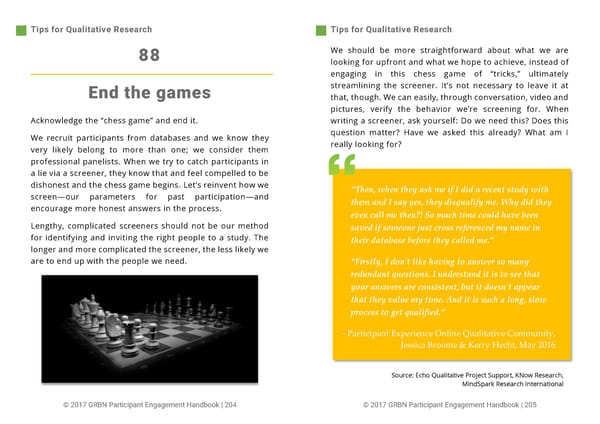Tips for Qualitative Research Tips for Qualitative Research 88 We should be more straightforward about what we are looking for upfront and what we hope to achieve, instead of engaging in this chess game of Ȋtricks,ȋ ultimately End the games streamlining the screener. It’s not necessary to leave it at that, though. We can easily, through conversation, video and pictures, verify the behavior we’re screening for. When Acknowledge the Ȋchess gameȋ and end it. writing a screener, ask yourself: Do we need this? Does this We recruit participants from databases and we know they question matter? Have we asked this already? What am I very likely belong to more than one; we consider them really looking for? professional panelists. When we try to catch participants in a lie via a screener, they know that and feel compelled to be dishonest and the chess game begins. Let’s reinvent how we screen—our parameters for past participation—and ȃThen, when they ask me if I did a recent study with encourage more honest answers in the process. them and I say yes, they disqualify me. Why did they even call me then?! So much time could have been Lengthy, complicated screeners should not be our method saved if someone just cross referenced my name in for identifying and inviting the right people to a study. The their database before they called me.Ȅ longer and more complicated the screener, the less likely we are to end up with the people we need. ȃFirstly, I don't like having to answer so many redundant questions. I understand it is to see that your answers are consistent, but it doesn't appear that they value my time. And it is such a long, slow process to get qualified.Ȅ - Participant Experience Online Qualitative Community, Jessica Broome & Kerry Hecht, May 2016 Source: Echo Qualitative Project Support, KNow Research, MindSpark Research International © 2017 GRBN Participant Engagement Handbook | 204 © 2017 GRBN Participant Engagement Handbook | 205
 101 Tips to Improve the Research Participant User Experience Page 102 Page 104
101 Tips to Improve the Research Participant User Experience Page 102 Page 104